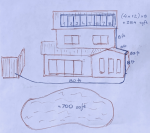Hi,
I started planing installation of solar panels to warm up our pool and after some reading I have big doubts if it will really change anything. On my draft below (not good proportions) you can see what I'm planing. I notice that some people here have a good knowledge and understanding how it works and even are able to calculate some elements of it.
My main concern is:
1) roof is facing north, about 20deg to the west, so obviously it is opposite of the recommended south side (location San Diego, roof pitch 5/12)
2) long distance and the second floor roof
80 ft underground + 8 ft up on the wall + 20 ft flat on the roof (or hidden on the wall) + 8 ft a bit up on a low pitch roof + 8 ft up to the main roof = total 124 ft
roof will fit only 8 panels (4x12) so it will create surface of 384 sqft so the needed pressure at the panels is 8 x 5 GPM = 40 GPM
3) small size of the heater system (384 sqft) comparing to the size of the pool (~700sqft)
To describe the situation on the draft the pump is located on the left and the solar heater pipes are already installed under the deck and they are going to the right side of the house. From that point I could add another 20ft on the wall which is shaded all the time, or as I draw it I will take it up (8ft) to the small roof and run next part (20ft) on the roof, then 90deg up the roof (8ft) to another wall, and take it up (8ft) to the main roof. I'm planing solar panel entry point (lowest point) on the right side of the roof so it will connect there directly to the panels.
Is there any way to verify if this is not to high and too far and if it will raise the temperature in the pool more than just 2-3deg? We do not have any pool cover.

I started planing installation of solar panels to warm up our pool and after some reading I have big doubts if it will really change anything. On my draft below (not good proportions) you can see what I'm planing. I notice that some people here have a good knowledge and understanding how it works and even are able to calculate some elements of it.
My main concern is:
1) roof is facing north, about 20deg to the west, so obviously it is opposite of the recommended south side (location San Diego, roof pitch 5/12)
2) long distance and the second floor roof
80 ft underground + 8 ft up on the wall + 20 ft flat on the roof (or hidden on the wall) + 8 ft a bit up on a low pitch roof + 8 ft up to the main roof = total 124 ft
roof will fit only 8 panels (4x12) so it will create surface of 384 sqft so the needed pressure at the panels is 8 x 5 GPM = 40 GPM
3) small size of the heater system (384 sqft) comparing to the size of the pool (~700sqft)
To describe the situation on the draft the pump is located on the left and the solar heater pipes are already installed under the deck and they are going to the right side of the house. From that point I could add another 20ft on the wall which is shaded all the time, or as I draw it I will take it up (8ft) to the small roof and run next part (20ft) on the roof, then 90deg up the roof (8ft) to another wall, and take it up (8ft) to the main roof. I'm planing solar panel entry point (lowest point) on the right side of the roof so it will connect there directly to the panels.
Is there any way to verify if this is not to high and too far and if it will raise the temperature in the pool more than just 2-3deg? We do not have any pool cover.


